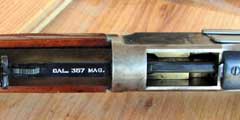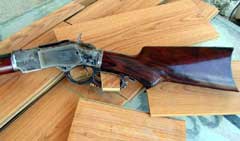|
In it's time
the 1873 Winchester, was the gun reported to have won
the West.
There is a lot of controversy to the truth or falseness
of that, the Henry, the 1866 Winchester the 1873 and
1876 all were a part of that great move west in our country.
But it can be clearly said the 1873 was the rifle that was
most sought after by those in the last three decades of the 19th
century.
The 44-40 was the caliber of choice, but the 38-40 was
selected by a good number of folks. In 1882 the 32-20 was
chambered also in the 1873 design but wasnít as popular as
the other two.
And
in those early days the chamberings were not called by
Winchester, by the powder weight,
38-Ď40' and 44-Ď40'... the big W called them the 44
WCF and the 38 WCF, for ĎWinchester Center Fireí.
Because
the designation WCF was a Winchester copyright... when other
ammo companies began to load for the rounds, they were called
by the powder names. And it stuck. And the mighty 38 WCF
(which was not a 38 at all, but a 401+ caliber), and the 44
WCF became the 38-40 and the 44-40, the chamberings of
choice.....
Today's
modern clone 1873s come in many calibers including the 44 WCF
and the 32-20 WCF... I am told they also come in the 38-40 but
I have yet to see one. Several
distributors have them also chambered in the more modern
calibers like the .357 magnum.
Since the toggle system design of the 1873s is not a
very strong system, with a very slim bolt... that chambering
surprises me. For
a design that was made to take 16,000 psi (to a top load of
23,000 psi in modern steel)... the 35,000 psi of todayís
commercial 357 loads is way over the stress points of the
design. And some
commercial ammo is still loaded to the original 357 pressure
levels of 45,000+ psi.
I
have a Uberti 1873 all steel action Short Rifle in .357
Magnum shown in the pictures.
It is a gorgeous rifle. With itís deep charcoal type
bluing and case colored action, the photos do not do the gun
justice. A 20
inch octagon barrel, that is usually the carbine length. But
this levergun has the rifle forearm, barrel, loading tube,
barrel band, and octagon barrel.
It weighs in at 7.4 pounds unloaded.
It has buck horn sights, but that will change as soon
as the peep sights I ordered come in from MidwayUSA.
The
wood is dense walnut with a goodly amount of figure, the
photos also donít show the grain very well.
In fact some of the weight comes from the heavy walnut
of the forearm and buttstock.
It has the traditional curved butt-plate of the 73s.
The butt-plate has the same blue as the barrel and
loading tube.
If
you look at the close-up photo of the brass lifter in the up
position (itís the photo looking down into the action), you
can see the bolt between the two sides of the brass lifter....
it is not very big in circumference, and itís somewhat long
and unsupported at firing.
And who knows how really strong it is, even if it is
steel and not brass. In my earlier testing of the 1873 steel
clone 32-20s, I found that they shouldnít be reloaded past
23,000 psi. That
is my arbitrary top loading pressure for new steel Ď73s.
In respect for the simple but weaker design.
The
one thing I have always loved about the
Henry through the 1876 rifles, which are basically the
same design, just different action sizes, is the smoothness of
the actions. And this Uberti is no exception. It is butter smooth.
The octagon barrel, steel action, and heavy wood give a
hefty but an Ďon pointí aiming ability to the rifle. Its
20 inch barrel is a bit nose heavy and hangs on the target.
Most
of
the reloading books call for top loads in pressure around
16,000 psi for well made and tight 73s.
With the modern steel 1873 action and smaller head size
of the .357 cartridge, I figure 20,000 to 23,000 psi isnít
going to hurt my rifle. I
have shot +P 38 Special commercial ammo out of it without
problems, and that was rated at 23,000+ psi.
So I believe extended use of 23,000 psi or below will
be fine. If I want true 357 mag rifle velocities, I have
Winchester and Legacy 1894 and 1892 designed leverguns
that can take top .357 magnum pressures. No sense hurting a
fine 1873 rifle.
With
powders I have found
that the old standbys like 2400 and H-4227 are very good ...
but HS-6 and Blue Dot in some loadings turned out very well.
For
example,
8 grains of Blue Dot under a 110 grain jacketed bullet will
give near 1450 fps from the rifle with only 17,500+ psi from
the 20 inch barrel.. A near magnum load from a short barreled
handgun. And it
will make a very bad day for a coyote inside 100 yards.....
Accurate #5 with 8 grains will push a 125 grain
jacketed bullet from the rifle at 1350+ fps for around 18,700
psi, and it is a neat
load out to 100 plus yards.
7 grains of HS-6 under a cast 158 grain Keith bullet
will go 1300 fps..... a modest 17,000 psi..... this load at 50
yards is ideal, going
into an inch+ when I hold well enough with buck horn sights... As most of my readers know, I am not a buck horn sight
aficionado.
And
using
any good reloading book, you can find many acceptable loads
for squirrel to coyotes in the 38 special plus P sections...
itís a fun gun. This gun is a low pressure thing of beauty,
fun to shoot, no recoil to speak of, accurate to a fault and a
fine small game rifle... And the word about its exceptional
accuracy has leaked out.... I hear the squirrels are picketing
the Uberti manufacturing plant.
Paco
Kelly
  
Got something to say about this article? Want to agree (or
disagree) with it? Click the following link to go to the GUNBlast Feedback Page.
|
|
Click pictures for a larger version.




|
![]()